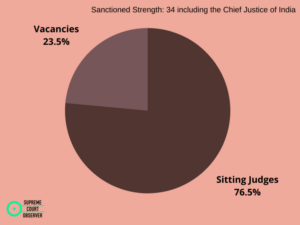Analysis
Pendency Rides High on the Second Wave, while Judgments Dip in 2021
We analyse the effect of the pandemic on pendency and the number of reported judgments at the Supreme Court.
The second wave of the pandemic has significantly shaped the statistical picture of the Supreme Court. We look at pendency, vacancies, number of judgments, and suo moto cases in the first half of 2021.
Pendency has historically been on a steady rise at the Supreme Court. However, the first half of 2021 has seen a steep increase of 6.3%. The data on pendency for each month is reported in the first 3 days of the month. So, we have included July to account for the pendency at the end of June.
Cases continue to be instituted, with easier access after the introduction of the ‘e-filing’ module. However, judicial time was restricted since the Court could not sit physically. The Court was opening gradually, with hybrid hearings taking place from 15th March. But with the second wave, the Court went back to hearing only ‘urgent cases’ from April 22nd 2021.
In the first half of 2017 pendency had decreased by 5% and in the same period in 2018, it had decreased by 0.3%. However, in the previous two years, there was an increase in the equivalent period of 2.2% (2019) and 0.9% (2020). This sets apart the 6.3% increase in 2021 as especially high.
Pendency is measured at two stages. The ‘admission stage’ is where the Court considers whether a certain petition should be heard orally. It can be disposed of at this stage if various procedural requirements are not met. If admitted, oral hearings are conducted in the ‘regular stage’. Over the first half of the year, pendency at the admission stage increased by 10.06%, whereas in the regular stage, it fell by 2.55%.
The Court also publishes data on the number of Constitution Benches pending. At the start of the year, there were 50 main matters pending. This number fell, but by the end of June, it had reached 50 again.
There is no reliable way to check the number of Constitution Bench matters disposed, besides a manual review. However, the Maratha Reservations judgment is one of the few Constitution Bench cases heard during the pandemic. Another Constitution Bench has dealt with cheque dishonour cases.
Vacancies

The sanctioned strength of judges at the Supreme Court is 34, including the Chief Justice of India. With the retirements of J Indu Malhotra, CJI SA Bobde and J Ashok Bhushan, and the death of J Shantangoudar, there have been 4 new vacancies since January 2021. This takes the total vacancies up to 8, and 26 sitting judges.
This leaves only one woman on the Bench, J Indira Banerjee, who is due to retire in August. There have been no collegium resolutions recommending appointments for any of these vacancies.
The number of ‘reported judgments’ is taken from the judgments uploaded on the Supreme Court of India website. This does not include all judgments, and does not indicate the number of cases disposed of in a given time period. However, it provides a general overview of the number of judgments pronounced by the Court.
The first 6 months of 2021 saw only 297 reported judgments, at an average of 49.5 per month. In 2020, the Court had pronounced 435 reported judgments and in 2019, 678. The pandemic is likely to have been a primary cause in the falling number of reported judgments.
We have also collected data on the number of suo moto writ petitions. There were nine suo moto cases initiated in the first half of 2020, seven of which were related to COVID. In the first half of 2021, there have been four new suo moto cases. Only one of these dealt with Covid.
As the Court continues to open once again, the number of reported judgments is likely to increase, and pendency will begin to be addressed. However, the unpredictable nature of the pandemic leaves very few things certain.
Note: ‘Reported Judgments’ is counted by looking at the serial number of judgments on the Supreme Court of India website when a search is done by date.
